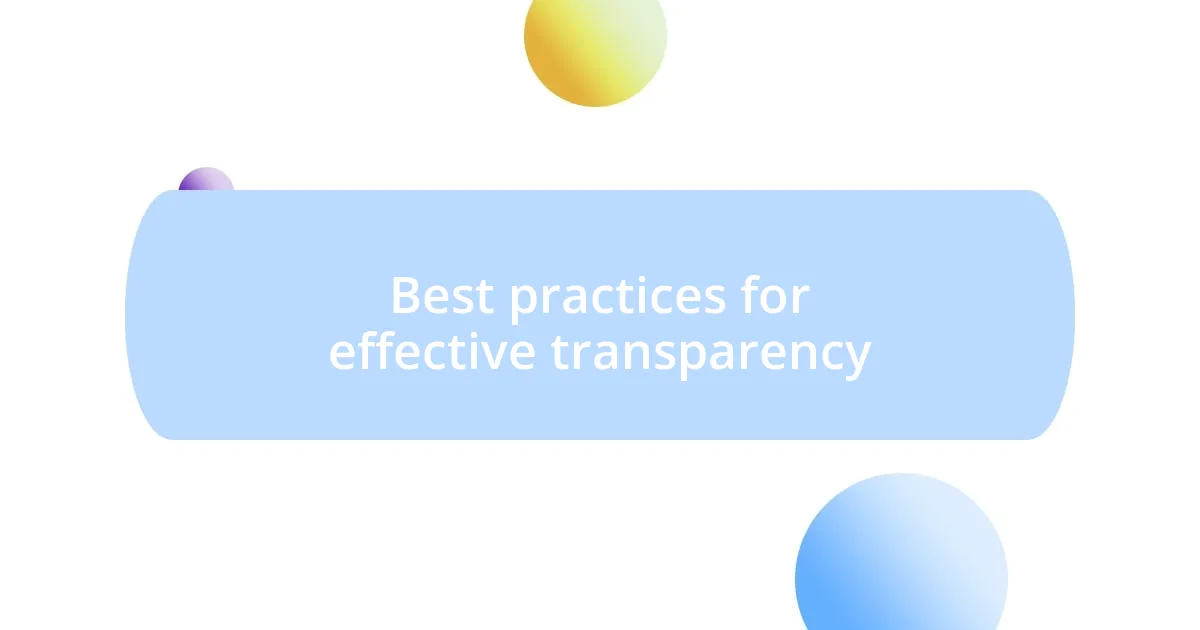Key takeaways:
- Transparency in fundraising builds trust among donors by clearly communicating fund usage and project progress.
- Key principles of transparency include openness in communication, accessibility of information, and accountability for actions.
- Effective transparency practices involve regular updates, visual storytelling, and engaging donors in decision-making processes.
- Tools such as online dashboards, third-party ratings, and social media enhance monitoring and accountability in fundraising efforts.

Understanding fundraising transparency
When I first got involved in fundraising, I quickly learned that transparency is more than just a buzzword; it’s a vital element that builds trust between organizations and their donors. Imagine donating your hard-earned money and later discovering it was mismanaged—how would you feel? This trust is fostered through clear communication about where the funds go and how they are used, ensuring that every donor feels valued and informed.
I remember attending a fundraising event where the organizers openly discussed their budget and outlined specific projects funded by previous campaigns. It was refreshing to see the detailed breakdown of expenses, and it made me feel more connected to the cause. This level of transparency not only reassured me as a donor but also motivated me to contribute, knowing exactly where my money would make an impact.
Have you ever questioned how your contributions are being utilized? That’s where transparency plays a crucial role. By providing real-time updates and accessible financial reports, organizations can empower their supporters and create a more engaged community, demonstrating accountability that resonates deeply with both current and potential donors.

Importance of fundraising transparency
Fundraising transparency is essential in establishing a relationship of trust between organizations and their supporters. In my own experience, I’ve seen how clear communication directly impacts donor loyalty. For instance, during one particular campaign, the organization I supported posted detailed updates about project progress and financial use on their website. It felt rewarding to watch the positive developments unfold and to know precisely how my contributions were being utilized. This openness not only strengthened my commitment but also encouraged others in my circle to get involved.
Here are some key reasons why fundraising transparency matters:
- Builds Trust: Donors are more likely to contribute to organizations they trust, knowing their funds are used effectively.
- Increases Engagement: When donors understand how their money supports a cause, they become more invested and passionate about the mission.
- Enhances Credibility: Organizations that practice transparency often stand out as credible options in a crowded fundraising landscape, attracting more support.
- Boosts Accountability: Transparency holds organizations accountable for their actions, fostering a culture of responsibility and ethical management.
Being transparent in fundraising is not just a nice-to-have; it’s a foundational aspect that can influence success and sustainability in the long run.

Key principles of transparency
One of the key principles of transparency is openness in communication, which I believe is the backbone of trustworthy fundraising practices. When organizations share detailed information about their operations, budgets, and outcomes, it builds a sense of community. For example, I once volunteered with a charity that held monthly meetings to discuss their financial standings and project progress. This not only let us, the volunteers, see how our efforts aligned with the organizations’ goals but also energized our fundraising endeavors. Knowing what was happening behind the scenes created a shared understanding that I found motivating.
Another important aspect of transparency is accessibility. I recall a time when I supported an initiative that published its financial reports and project updates in an easy-to-understand format. It was refreshing to see the organization breaking down complex data into digestible graphics. This simple act made me feel included and appreciated, showing that they cared about their donors’ understanding. Accessible information fosters an environment where donors feel empowered to engage further, a principle I hold dear based on my experiences.
Lastly, accountability completes the triad of transparency principles. I once faced a situation where an organization I trusted failed to deliver on its promises, and I felt let down because they didn’t admit mistakes or share their struggles openly. This experience made it clear to me that organizations must own up to their challenges to maintain integrity. Transparent organizations that accept responsibility and communicate challenges honestly often inspire deeper trust among supporters.
| Principle | Description |
|---|---|
| Openness in Communication | Sharing detailed information fosters trust and community. |
| Accessibility | Presenting information simply ensures all donors can engage meaningfully. |
| Accountability | Owning mistakes and communicating challenges builds integrity and trust. |

Best practices for effective transparency
When implementing effective transparency in fundraising, it’s vital to establish regular communication channels. I recall a campaign I followed that sent out bi-weekly emails detailing the use of funds and project milestones. These updates made me feel part of something bigger; it wasn’t just about the money, but how it was fostering real change. Have you ever felt that sense of inclusion? It transforms the donor experience entirely.
Another best practice revolves around visual storytelling. I remember seeing infographics that illustrated the impact of donations. Instead of chart-heavy reports, these visuals captured hearts and minds—making it easier for donors to connect emotionally with their contributions. It’s fascinating how a simple design choice can elevate understanding and involvement, don’t you think?
Lastly, involving donors in decision-making enhances transparency immensely. I was once part of a fundraising effort that sought donor feedback on project selection. The organization actively requested input, which made me feel valued and heard. This participatory approach not only deepened my loyalty but also cultivated a sense of ownership among the donors. How empowering is it to know your voice matters in guiding a mission? I believe this level of engagement differentiates organizations that merely seek funding from those that genuinely foster a community of support.

Tools for monitoring transparency
One tool I find invaluable for monitoring transparency in fundraising is online dashboards. I recall a project where the organization implemented a real-time dashboard that tracked donations, project spending, and outcomes. It felt exhilarating to see the impact of my contribution materialize right before my eyes. This immediate access illustrated how funds were being allocated in a way that felt transparent and accountable—don’t you agree that’s how every donor should feel?
Another effective tool is third-party platforms that analyze and rate organizations based on their transparency and financial health, like Charity Navigator. I remember searching for a charity to support, and these ratings helped me sift through options quickly. It was comforting to rely on an external source that didn’t just rate based on buzzwords but provided in-depth insights about how funds were being utilized. Imagine how much easier choosing where to contribute could be with such tools!
Moreover, social media can serve as a powerful platform for transparency. A friend of mine was involved in a nonprofit that shared updates on their projects via live streams and stories. This real-time engagement made it feel like we were all part of the journey together. I found it captivating how these platforms fostered community and held organizations accountable to their promises. Doesn’t it feel reassuring to know you can check in on your favorite causes anytime?

Building trust through transparency
Trust is a crucial element in fundraising, and transparency plays a pivotal role in building it. I remember volunteering for a local charity where they openly shared their financial reports during community meetings. Being able to see where every dollar went not only put my mind at ease but also made me more enthusiastic about asking my friends to contribute. Isn’t it remarkable how information can foster such confidence?
When an organization commits to sharing its processes and outcomes, it creates a sense of accountability. I’ve participated in campaigns where they showcased video testimonials from recipients, illustrating the impact donations had on individuals’ lives. Those heartfelt stories resonated with me, leading to a stronger connection and belief in the cause. Don’t you think that when we witness the direct outcomes of our contributions, we feel more invested in the mission?
Additionally, I find that open communication during challenging times is a true testament to transparency. There was a nonprofit I supported that faced unexpected setbacks but chose to keep its donors informed every step of the way. Their honesty about the challenges, paired with a clear plan for moving forward, reinforced my trust in them. How powerful is it to witness vulnerability coupled with commitment? It’s this kind of transparency that truly differentiates organizations that thrive from those that struggle to maintain trust.














